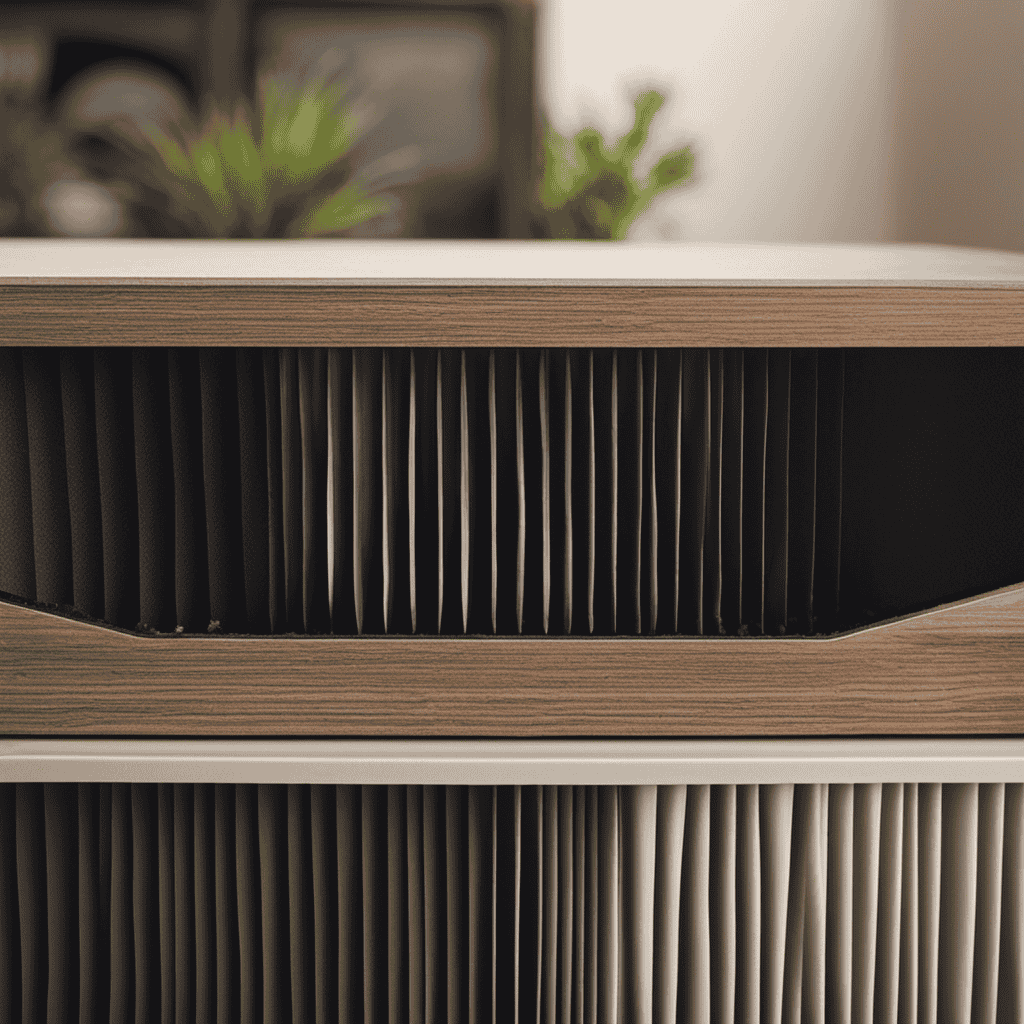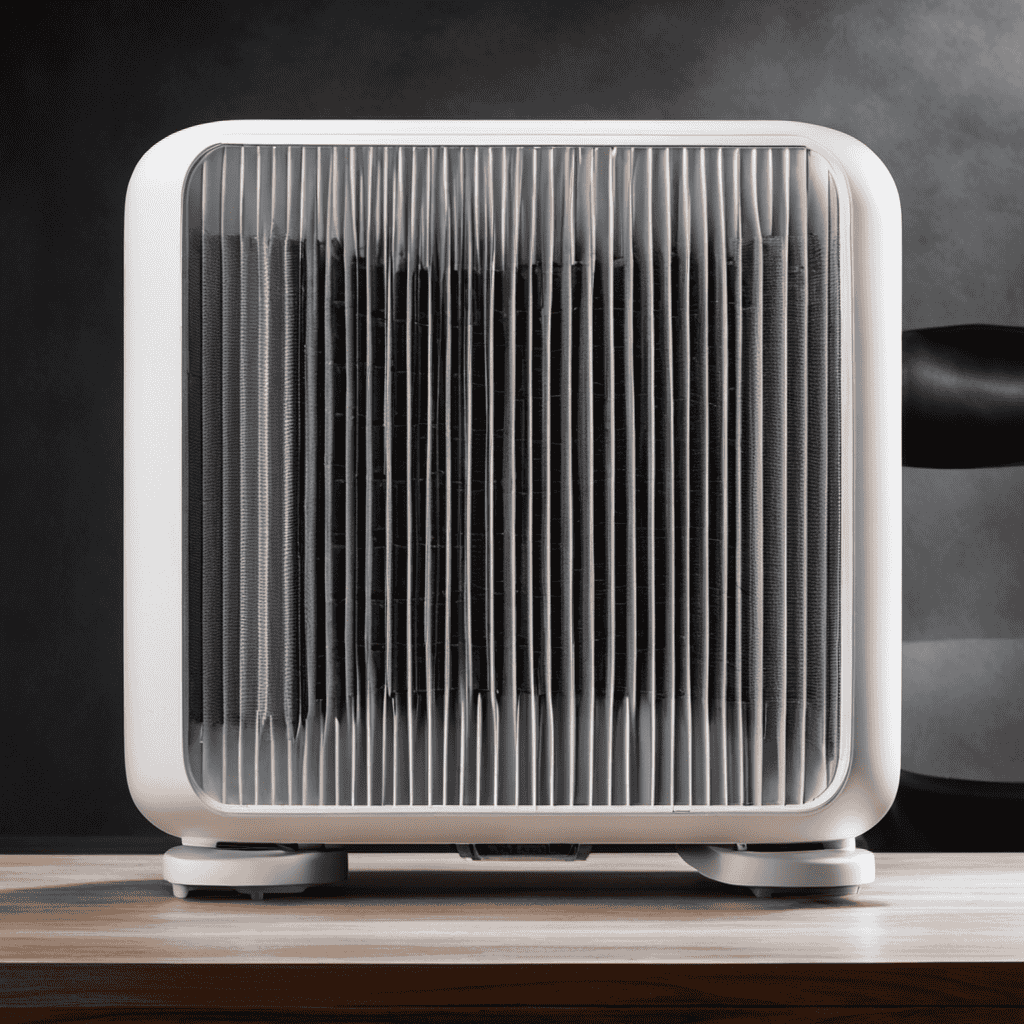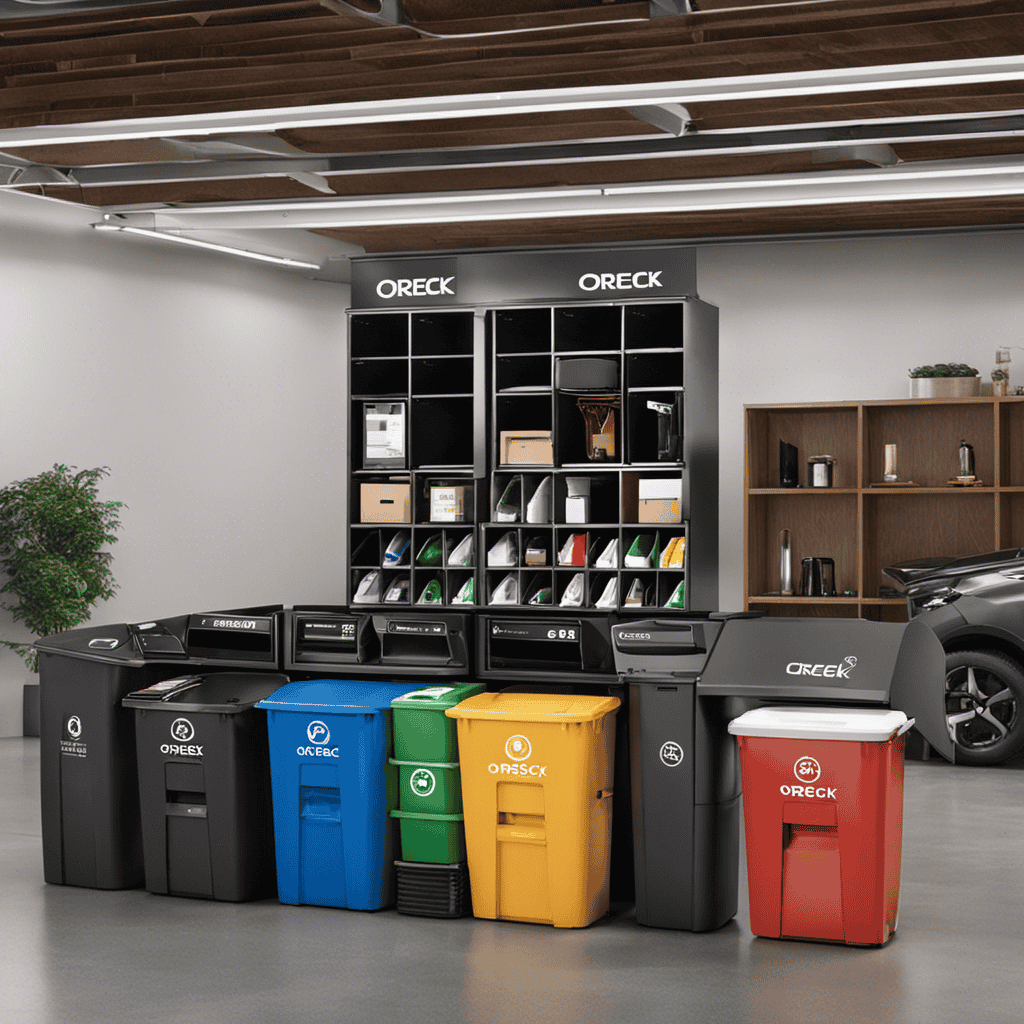I have always been worried about the air quality in my surroundings, especially at home. This is why I decided to purchase an air purifier.
But recently, I started wondering just how often I should be cleaning the filter to ensure optimal performance. After conducting some research, I discovered some surprising facts and crucial information that I want to share with you.
In this article, I will explore the importance of regular filter cleaning, factors that affect cleaning frequency, and provide expert tips on how to properly clean your air purifier filter.
Let’s take a deep breath and dive in!
Key Takeaways
- Regular cleaning of the air purifier filter is important for optimal performance and to prolong the lifespan of the air purifier.
- Factors such as pet dander, dust levels, and allergens present in the area can influence the frequency of filter cleaning.
- It is essential to follow the manufacturer’s recommendations for cleaning, as different air purifier models have specific guidelines.
- Signs that indicate the need for filter cleaning include foul odors, reduced air flow from the purifier, and an increase in allergies.
Importance of Regular Filter Cleaning
Regularly cleaning your air purifier filter is important to ensure its optimal performance. The filter cleaning frequency depends on various factors, such as the manufacturer’s recommendations, the air quality in your surroundings, and the usage of the purifier. Generally, it is recommended to clean the filter every 3 to 6 months, but this can vary.
Regular maintenance has several benefits. Firstly, it improves the efficiency of the air purifier by removing accumulated dust, pollen, and other particles from the filter. This allows the purifier to effectively capture and remove airborne contaminants, improving the overall air quality in your home. Secondly, regular filter cleaning prolongs the lifespan of the air purifier, reducing the need for costly replacements. By ensuring the filter is clean, you can maximize the performance and longevity of your air purifier.
Transitioning into the next section, let’s explore the factors that can affect the cleaning frequency of your air purifier filter.
Factors Affecting Cleaning Frequency
You should consider factors such as pet dander, dust levels, and allergens in your area when deciding how frequently to clean your air purifier filter. These factors can greatly affect the amount of time it takes for your filter to get dirty and clogged.
Here are three important factors to consider:
-
Pet dander: If you have pets in your home, their fur and dander can quickly accumulate in your air purifier filter. This can lead to reduced air flow and less effective filtration. Regular cleaning is essential to maintain optimal performance.
-
Dust levels: The amount of dust in your home can vary depending on factors such as location, weather, and lifestyle. If you live in a dusty area or have a lot of dust-producing activities, like woodworking or renovations, you may need to clean your filter more frequently.
-
Allergens in your area: Different regions have different allergens present in the air. If you live in an area with high pollen counts or other allergens, it may be necessary to clean your filter more often to ensure it can effectively capture and remove these particles.
Now that you know the factors affecting cleaning frequency, it’s important to be aware of common mistakes to avoid during the cleaning process. One common mistake is not following the manufacturer’s instructions. Each air purifier model may have specific cleaning guidelines, such as how often to clean the filter or how to properly clean it.
Another mistake is not cleaning the entire air purifier system. While cleaning the filter is crucial, it’s also important to clean other parts of the air purifier, such as the fan or vents, to ensure proper functioning.
Lastly, some people may forget to replace the filter if it’s not washable. Regularly checking and replacing the filter when necessary is essential for optimal air quality.
Manufacturer’s Recommendations for Cleaning
It’s important to follow the manufacturer’s recommendations for cleaning your air purifier filter to ensure optimal performance.
Different air purifier models have different filter cleaning techniques, so it’s crucial to consult the user manual or contact the manufacturer for specific instructions.
One common mistake people make is not cleaning the filter often enough. Neglecting regular cleaning can lead to a decrease in the air purifier’s efficiency and effectiveness.
On the other hand, some individuals may clean the filter too frequently, thinking it will improve air quality. However, excessive cleaning can damage the filter and reduce its lifespan.
Another mistake is not using the proper cleaning method. Some filters can be vacuumed, while others require washing. Using the wrong cleaning technique can damage the filter and compromise its performance.
Signs That Your Filter Needs Cleaning
I’ve noticed a few signs that indicate when my air purifier filter needs cleaning.
One of the most noticeable signs is when foul odors start to emanate from the purifier. This is a clear indication that dirt and other contaminants have built up on the filter, causing it to become less effective in removing pollutants from the air.
Additionally, I’ve noticed a reduced air flow coming from the purifier, which is another sign that the filter is dirty and needs cleaning. This reduced air flow can hinder the purifier’s ability to properly circulate and clean the air in the room.
Lastly, I’ve experienced an increase in allergies when the filter is dirty. This is because a dirty filter is not able to effectively capture allergens like dust, pollen, and pet dander, leading to an increase in allergy symptoms.
Foul Odors Indicate Dirt
If foul odors are present, that’s a clear indication that your air purifier filter is dirty and needs to be cleaned. Foul odors can be caused by the accumulation of dust, pet dander, and other pollutants in the filter. To ensure the efficiency of your air purifier and maintain clean indoor air, it is essential to clean the filter regularly. Here are three reasons why foul odors indicate that your filter needs cleaning:
-
Reduced filtration efficiency: A dirty filter hampers the air purifier’s ability to trap airborne contaminants effectively. This can lead to foul odors lingering in the air, as the filter is unable to remove them completely.
-
Increased maintenance: When the filter is dirty, the air purifier has to work harder to maintain clean air. This increased workload can result in decreased performance and increased wear and tear on the device, requiring more frequent maintenance.
-
Filter replacement: Neglecting to clean the filter regularly can lead to its premature deterioration. A dirty filter may become clogged, reducing its lifespan and ultimately requiring a replacement sooner than expected.
Regularly cleaning your air purifier filter will help eliminate foul odors, improve filtration efficiency, reduce maintenance needs, and prolong the life of the filter.
Reduced Air Flow
When the airflow is restricted, foul odors may linger in the room despite the air purifier being on. This is because reduced air flow can lead to increased energy consumption and reduced filter efficiency.
When the air purifier is not able to effectively circulate the air in the room, it can result in the accumulation of pollutants and odors. This not only affects the quality of the air but also puts additional strain on the air purifier.
The restricted airflow can cause the air purifier to work harder, leading to increased energy consumption. Additionally, when the air flow is limited, the filter may not be able to capture and remove contaminants efficiently, reducing its overall effectiveness.
Therefore, it is important to regularly clean and maintain the air purifier to ensure optimal airflow and prevent foul odors from lingering in the room.
Increase in Allergies
An increase in allergies can be attributed to factors like pollen, dust, and pet dander present in the air. These allergens can trigger a variety of symptoms, including sneezing, congestion, and itchy eyes.
As someone who suffers from allergies, I understand the impact they can have on daily life. Here are three ways allergies can impact indoor air quality and increase the risk of asthma:
-
Allergens in the air can accumulate on surfaces, leading to poor indoor air quality. Regular cleaning and dusting can help reduce the allergen levels in your home.
-
Mold spores can thrive in damp and humid environments, triggering allergic reactions. Proper ventilation and moisture control can help prevent the growth of mold.
-
Airborne irritants like cigarette smoke and strong odors can worsen allergy symptoms. Using air purifiers with HEPA filters can help remove these pollutants from the air.
How to Properly Clean an Air Purifier Filter
To properly clean an air purifier filter, you should follow the manufacturer’s instructions. Proper cleaning techniques are essential to maintain the efficiency and longevity of your air purifier. Cleaning the filter regularly not only improves its performance but also prevents potential damage.
Most air purifiers come with a washable or replaceable filter, and it is crucial to know which type you have. If it is washable, gently remove the filter and rinse it under running water. Avoid using harsh chemicals or scrubbing vigorously, as this can damage the filter. Allow the filter to air dry completely before reinstalling it.
By following these proper cleaning techniques, you can ensure that your air purifier functions effectively and efficiently.
Now, let’s move on to the tools and supplies needed for cleaning.
Tools and Supplies Needed for Cleaning
Now that we know how to properly clean an air purifier filter, let’s talk about the tools and supplies you’ll need for the job.
Having the right cleaning supplies and using proper techniques is essential to ensure your air purifier is thoroughly cleaned and maintained. Here are three items you’ll need:
-
Soft-bristle brush: This will help you gently remove dust and debris from the filter without causing any damage. Avoid using harsh brushes or rough materials that could tear or compromise the filter’s integrity.
-
Mild detergent: Using a mild detergent mixed with warm water can effectively remove trapped particles and contaminants from the filter. Be sure to follow the manufacturer’s instructions and avoid using any abrasive or harsh chemicals that could harm the filter.
-
Microfiber cloth: This soft and lint-free cloth is perfect for drying the filter after cleaning. It won’t leave any residue or fibers behind, ensuring the filter is clean and ready to use again.
Having these cleaning supplies and using proper techniques will help you maintain the efficiency and performance of your air purifier filter.
Step-by-Step Guide to Cleaning the Filter
Let’s dive right into the step-by-step guide for cleaning your air purifier filter.
Proper cleaning techniques are essential to ensure optimal performance and longevity of your air purifier.
First, make sure to check the manufacturer’s instructions for specific cleaning recommendations.
Start by turning off and unplugging the air purifier.
Carefully remove the filter from the unit, being cautious not to damage it.
Most filters can be cleaned with a vacuum cleaner or by rinsing it with water.
Gently remove any visible debris or dirt using a soft brush or cloth.
Allow the filter to dry completely before reinstalling it into the air purifier.
Following these proper cleaning techniques will help prevent potential damage to the filter.
Now, let’s move on to the next section and discuss common mistakes to avoid during cleaning.
Common Mistakes to Avoid During Cleaning
When it comes to cleaning an air purifier, it’s important to use proper cleaning techniques to ensure its optimal performance.
In this discussion, we will explore the correct methods for cleaning an air purifier, including the proper way to clean the filter, as well as potential damage prevention techniques.
Proper Cleaning Techniques
Properly cleaning your air purifier filter is essential to maintain its efficiency. Here are three effective cleaning methods that can help you ensure the longevity of your filter:
-
Regular vacuuming: Use a vacuum cleaner with a brush attachment to gently remove dust and debris from the surface of the filter. This method is quick and easy, and it helps to prevent clogs.
-
Rinse with water: For washable filters, rinsing with water can be an effective cleaning technique. Simply remove the filter and rinse it under running water until it is clean. Be sure to let it dry completely before reinstalling.
-
Use a cleaning solution: Some filters may require a deeper clean. In these cases, you can use a mild cleaning solution specifically designed for air purifier filters. Follow the instructions on the product carefully to avoid damaging the filter.
By following these proper cleaning techniques, you can keep your air purifier filter in top condition and ensure optimal performance.
Now, let’s discuss some tips on potential damage prevention.
Potential Damage Prevention
Now that we’ve covered the proper cleaning techniques for air purifier filters, let’s discuss potential damage prevention and how it can help extend the filter’s lifespan.
One way to prevent damage to your air purifier filter is by avoiding excessive force when handling it. Filters are delicate and can tear easily if mishandled. Additionally, it’s important to keep the filter away from direct sunlight or heat sources, as this can cause damage and reduce its effectiveness.
Regular maintenance is another key factor in preventing damage and extending the filter’s lifespan. This includes vacuuming the pre-filter regularly to remove larger particles and debris. Additionally, replacing the filter according to the manufacturer’s instructions is crucial. Neglecting to do so can lead to reduced air quality and potential damage to the air purifier itself.
Cleaning Frequency for Different Types of Filters
To keep your air purifier working efficiently, it’s important to know how often to clean different types of filters. Cleaning schedules may vary depending on the type of filter material used. Here are three common types of filters and their recommended cleaning frequencies:
-
Pre-filter: This filter captures large particles like dust and pet hair. It should be cleaned every two to four weeks, or when visibly dirty.
-
Carbon filter: This filter helps remove odors and chemicals from the air. It typically needs replacement every three to six months, depending on usage and the level of pollutants in your environment.
-
HEPA filter: This high-efficiency filter traps small particles and allergens. It is recommended to vacuum or gently brush the filter every three to six months to remove accumulated dirt and maintain optimal performance.
By following a regular cleaning schedule for your air purifier filters, you can ensure that your unit continues to provide clean and fresh air for you and your family.
Now, let’s explore how to extend the lifespan of your filter.
How to Extend the Lifespan of Your Filter
By following these simple tips, you can extend the lifespan of your filter.
Regular maintenance is key to ensuring that your filter operates efficiently and effectively. First and foremost, make sure to clean or replace your filter according to the manufacturer’s recommendations. This will prevent clogging and maintain optimal airflow.
Additionally, keep your filter in a clean environment, away from dust and debris. Dust and dirt can accumulate on the filter and reduce its effectiveness over time.
Another tip is to vacuum the area around your filter regularly to prevent any particles from entering and damaging the filter.
Finally, consider using a pre-filter to catch larger particles before they reach the main filter, further extending its life.
Benefits of Regular Filter Maintenance
Regular filter maintenance has numerous benefits that contribute to a healthier living environment.
Firstly, it improves air quality by effectively removing harmful pollutants such as dust, allergens, and pet dander.
Secondly, it extends the lifespan of your device by preventing clogging and reducing strain on the motor.
Lastly, it is a cost-effective maintenance practice as it reduces the need for frequent filter replacements and ensures optimal performance of your air purifier.
Improved Air Quality
Having a clean air purifier filter can significantly improve the quality of the air in your home. Not only does it help remove pollutants and allergens, but it also promotes improved health and energy efficiency.
Here are three reasons why a clean air purifier filter is essential:
-
Reduced Allergens: A clean filter captures and traps airborne allergens like dust, pollen, and pet dander, helping to alleviate allergy symptoms and improve respiratory health. Breathing cleaner air can lead to better sleep and overall well-being.
-
Increased Energy Efficiency: When a filter is clogged with dirt and debris, your air purifier has to work harder to circulate air. By regularly cleaning or replacing the filter, you can improve the unit’s energy efficiency, saving you money on your energy bills.
-
Longer Lifespan: A clean air purifier filter ensures that the unit operates at its optimal level, preventing strain on the motor and prolonging its lifespan. Regular maintenance can help you get the most out of your investment in an air purifier.
Longer Device Lifespan
A clean filter ensures that your air purifier operates at its best, prolonging its lifespan. Regular filter maintenance is crucial for increasing filter efficiency and keeping your air purifier running smoothly.
Here are some tips to help you maintain your air purifier filter effectively.
Firstly, check the manufacturer’s instructions for specific cleaning recommendations. Most filters can be cleaned by gently vacuuming or rinsing with water. However, make sure to let the filter dry completely before reinstalling it.
Additionally, it’s important to replace your filter according to the manufacturer’s guidelines. Over time, filters become clogged with particles, reducing their effectiveness.
Cost-Effective Maintenance
In my previous discussion about extending the lifespan of air purifiers, I emphasized the importance of regular maintenance. Now, let’s delve into cost-effective techniques and efficient cleaning methods that can save you money in the long run.
-
Utilize reusable filters: Instead of continuously purchasing disposable filters, opt for reusable ones. These can be easily cleaned and reused, reducing the need for frequent replacements and saving you money.
-
Vacuum the pre-filter: The pre-filter, which traps larger particles, can be vacuumed regularly to remove accumulated dust and debris. This simple step prevents clogging and maintains optimal airflow, ensuring the air purifier operates efficiently.
-
Consider DIY cleaning solutions: Rather than buying expensive cleaning products, you can make your own using common household items like vinegar and water. This not only saves money but also eliminates the use of harsh chemicals that may be harmful to your health or the environment.
How Dirty Filters Impact Air Quality
Dirty filters can negatively impact air quality in your home. When air passes through a dirty filter, it becomes clogged with dust, pollen, and other airborne particles. This reduces the efficiency of the filter, allowing these pollutants to circulate freely in your living space. Not only does this compromise the cleanliness of the air you breathe, but it can also have serious implications for your respiratory health.
A dirty filter can lead to increased symptoms of allergies and asthma, as well as respiratory infections. The particles trapped in the filter can also cause irritation and inflammation in the airways, exacerbating existing respiratory conditions. Additionally, dirty filters can hinder the performance of your air purifier, making it less effective in removing pollutants from the air.
To illustrate the impact of dirty filters, here is a table showing the potential consequences:
| Dirty Filter Performance | Impact on Respiratory Health |
|---|---|
| Reduced efficiency | Increased allergies |
| Circulation of pollutants | Worsened asthma symptoms |
| Hindered air purifier | Higher risk of infections |
Regularly cleaning or replacing your air purifier filter is crucial to maintain good air quality and protect your respiratory health.
Cleaning Vs. Replacing the Filter: When to Choose
When it comes to maintaining air purifiers, one key decision is whether to clean or replace the filter. The choice depends on various factors, such as the type of filter, the level of dirt and debris, and the manufacturer’s recommendations.
Additionally, it is important to consider the frequency of filter maintenance, as this can impact the overall effectiveness of the air purifier in improving indoor air quality.
Cleaning or Replacing
To keep your air purifier working effectively, you should regularly clean or replace the filter. Proper filter maintenance is essential for maintaining good indoor air quality. Here are three cleaning techniques to help you keep your air purifier filter in top shape:
-
Vacuuming: Use a soft brush attachment to gently remove dust and debris from the filter. This will help prolong its lifespan and maintain optimal performance.
-
Washing: Some filters are washable. Follow the manufacturer’s instructions to clean them properly. Be sure to let the filter dry completely before reinserting it into the air purifier.
-
Filter replacement: If your filter is not washable or is damaged, it’s time to replace it. Check the manufacturer’s recommendations for the recommended replacement schedule.
Regularly cleaning or replacing your air purifier filter will ensure that it effectively removes pollutants from your indoor air.
In the next section, we will discuss the frequency of filter maintenance.
Filter Maintenance Frequency
Regularly maintaining your air purifier filter is crucial for optimal performance and clean indoor air. The frequency at which you should clean your filter depends on several factors. These include the type of air purifier you have, the level of pollutants in your environment, and the manufacturer’s recommendations. Cleaning your filter too often can reduce its effectiveness, while not cleaning it enough can hinder its performance.
Here is a table summarizing the factors affecting cleaning frequency:
| Factors Affecting Cleaning Frequency |
|---|
| Type of Air Purifier |
| Level of Pollutants in Environment |
| Manufacturer’s Recommendations |
Regular maintenance of your air purifier filter offers numerous benefits. Firstly, it ensures that your air purifier is working efficiently and effectively, removing pollutants and allergens from the air. This leads to cleaner indoor air, which is particularly beneficial for individuals with respiratory conditions or allergies. Additionally, regular maintenance can extend the lifespan of your air purifier, saving you money in the long run. By following the manufacturer’s recommendations and considering the specific factors affecting cleaning frequency, you can enjoy the full benefits of your air purifier and maintain a healthier indoor environment.
Cleaning Tips for Specific Air Purifier Models
There are specific cleaning tips for different air purifier models that can help maintain their efficiency. As an owner of an air purifier, I have learned a few cleaning techniques that have made a noticeable difference in the performance of my unit.
Here are three cleaning tips that have worked well for me:
-
Regularly clean the pre-filter: The pre-filter is the first line of defense in trapping large particles like dust and pet hair. By vacuuming or washing the pre-filter every few weeks, you can prevent it from becoming clogged and ensure optimal airflow.
-
Use appropriate cleaning supplies: Different air purifier models have different requirements when it comes to cleaning supplies. It’s important to follow the manufacturer’s recommendations and use the appropriate cleaning products to avoid damaging the unit.
-
Clean the main filter periodically: Depending on the air quality and usage, the main filter may need to be cleaned or replaced every few months. Follow the manufacturer’s instructions for cleaning or replacing the filter to maintain the unit’s efficiency.
Troubleshooting Filter Cleaning Issues
In my experience with air purifiers, I have encountered some common issues when it comes to troubleshooting filter cleaning. It’s important to address these issues to ensure the optimal performance of your air purifier. Here are some of the most common problems and their possible solutions:
| Common Issue | Solution |
|---|---|
| Filter not cleaning properly | Ensure that the filter is installed correctly and securely. If the problem persists, try cleaning the filter more thoroughly or replacing it altogether. |
| Filter becoming clogged quickly | Check if there is excessive dust or debris in the room. It may be necessary to clean the surrounding area more frequently to prevent the filter from getting clogged. |
| Filter emitting an unpleasant odor | This could indicate that the filter needs to be replaced. If the odor persists after replacing the filter, it may be necessary to clean the air purifier’s internal components. |
Frequently Asked Questions
Can I Clean My Air Purifier Filter With Water?
Yes, you can clean your air purifier filter with water. It is one of the alternative cleaning methods available. Regular filter cleaning is important as it helps maintain the effectiveness and efficiency of your air purifier.
How Long Does It Take for a Filter to Dry After Cleaning?
After cleaning my air purifier filter, I was curious about how long it takes to dry. It’s important to regularly clean the filter to maintain its effectiveness. Different filter cleaning methods may require varying drying times.
Are There Any Health Risks Associated With Not Cleaning the Air Purifier Filter Regularly?
Not cleaning the air purifier filter regularly can pose health risks. Accumulated dust, allergens, and pollutants can circulate in the air, leading to respiratory issues. It is essential to follow maintenance guidelines for optimal health benefits.
Can I Clean My Air Purifier Filter Too Often?
Cleaning your air purifier filter too often can actually decrease its effectiveness. It is recommended to follow the manufacturer’s guidelines for air purifier maintenance, which usually includes cleaning the filter every 3-6 months. Dry cleaning is also an option.
Are There Any Alternative Methods to Clean the Air Purifier Filter Besides the Manufacturer’s Recommendations?
There are alternative cleaning methods for air purifier filters besides the manufacturer’s recommendations. DIY filter cleaning is one option to consider, but it’s important to research and follow proper guidelines to ensure effectiveness and safety.
– How Often Should I Clean My Air Purifier Filter?
To maintain optimal performance, regular cleaning of your air purifier filter is essential. Most manufacturers recommend cleaning air purifier filters every 30 days. However, factors such as air quality and usage can vary, so it’s best to check the specific guidelines for your model. Regular cleaning of the air purifier filter can improve air quality and extend the life of the unit.
Conclusion
In conclusion, regular cleaning of your air purifier filter is crucial for maintaining good air quality in your home. Neglecting to clean the filter can lead to a buildup of dirt, dust, and allergens, which can negatively impact your health.
By following the manufacturer’s recommendations and paying attention to signs that your filter needs cleaning, you can ensure that your air purifier is running efficiently. A dirty filter not only affects the performance of your air purifier but also the quality of the air you breathe.
So, don’t wait, start cleaning your filter today and breathe easy knowing you’re taking steps to improve your indoor air quality.










